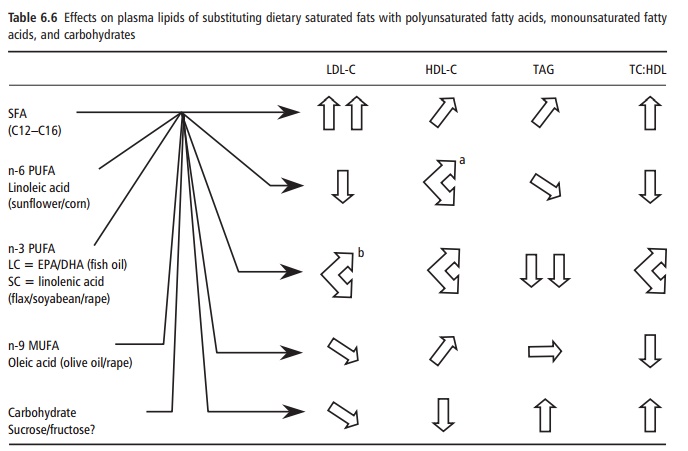Chapter: Introduction to Human Nutrition: Nutrition and Metabolism of Lipids
Effects of n-3 polyunsaturated fatty acids from plants and fish
Effects of n-3 polyunsaturated fatty acids from plants and fish
The current dietary recommendation for the intake of long-chain n-3 PUFAs (eicosapentaenoic acid/doc-osahexaenoic acid) in the UK is 450 mg/day (SACN, 2004). This was to increase intake by consuming two portions of fish per week, one of which should be oily (e.g., mackerel, sardines). This recommendation was based on evidence from a host of epidemiological and intervention studies, which showed that regular fish consumption could reduce the risk of sudden cardiac death. Since this an acute end-point of CHD, the ben-efits of fish oil have been ascribed to the prevention of fatal cardiac arrhythmia, and, to a lesser extent, coronary thrombosis, but not to any favorable effects on blood lipids. However, there is also convincing evidence to show that fish oil supplementation (1 g/ day for 3 years) reduces the incidence of death from CHD in healthy, free-living subjects. This longer term benefit may be linked to the effects of eicosapentae-noic acid/docosahexaenoic acid on a host of other cardiovascular risk factors, including plasma TAGs and lipoproteins.
Long-chain n-3 PUFAs exert multiple effects on lipid metabolism, the most notable of which is the capacity to decrease postabsorptive plasma TAG levels by 20–30%. Fish oil-enriched diets have also been shown to attenuate the magnitude and duration of postprandial lipemia following the ingestion of a fat-containing meal. These effects are frequently accom-panied by beneficial changes in circulating LDLs and HDLs, and the correction of an ALP.
Widespread knowledge of the favorable effects of eicosapentaenoic acid and docosahexaenoic acid has raised awareness of the need to increase intakes of these fatty acids, and to reduce the amount of n-6 PUFA at the same time. However, in practice, this will be difficult to achieve, not least because of a mass resistance to the increased consumption of oily fish and diminishing fish stocks. An obvious alternative would be to increase the intake of the shorter chain precursor of eicosapentaenoic acid/docosahexaenoic acid, α-linolenic acid (C18:3n-3). The latter is derived from plant seeds such as flax and rapeseed, and is desaturated and elongated to its longer chain relatives in the body. Unfortunately, the rate of conversion to eicosapentaenoic acid and especially docosahexaenoic acid is slow, and the efficiency of conversion is reduced by high levels of linoleic acid, which competes more effectively than α-linolenic acid for desaturation. There is, as yet, no evidence to suggest that the rate of conversion of dietary α-linolenic acid to eicosa-pentaenoic acid and especially docosahexaenoic acid is sufficient to achieve fish oil-like effects on blood lipids (Table 6.6).

Related Topics